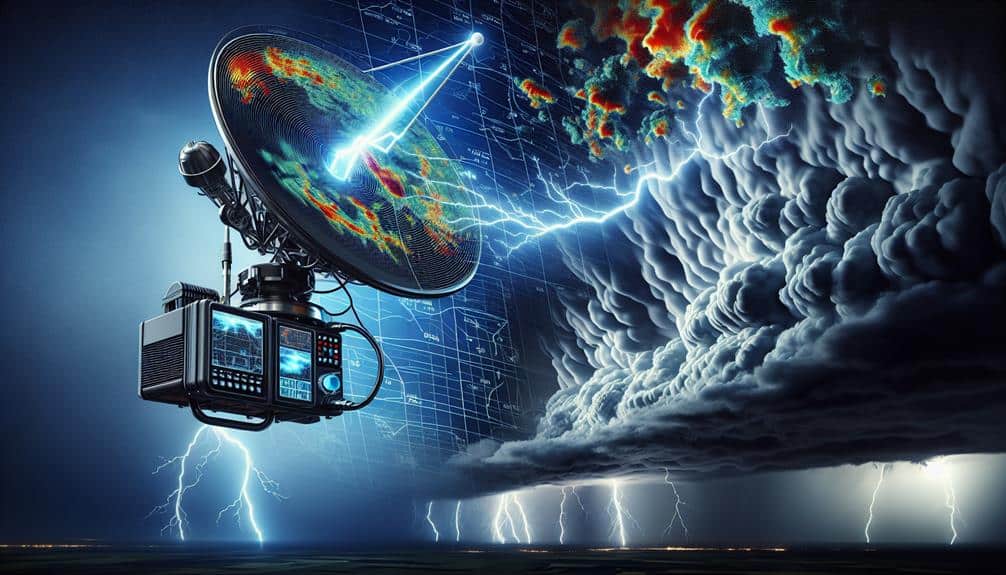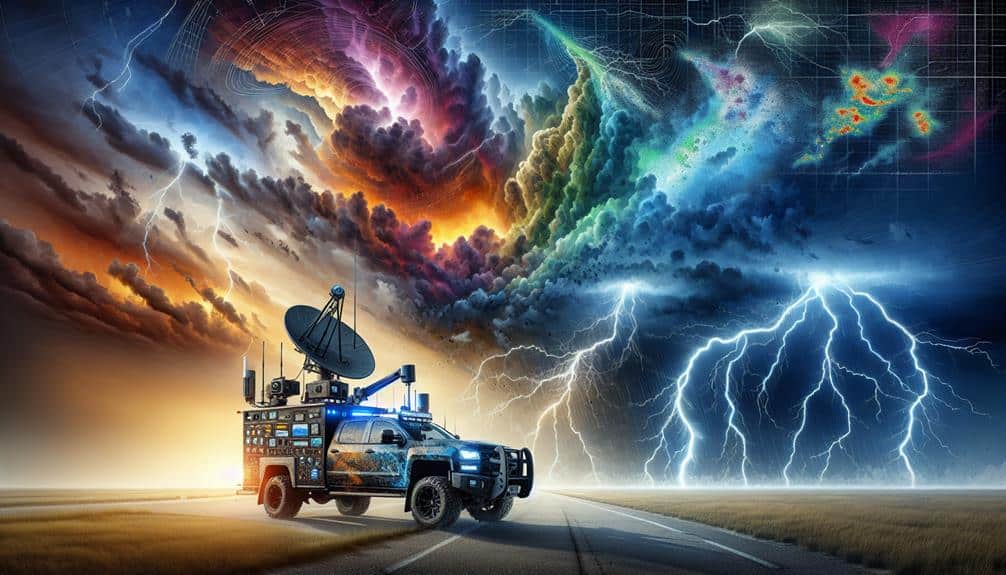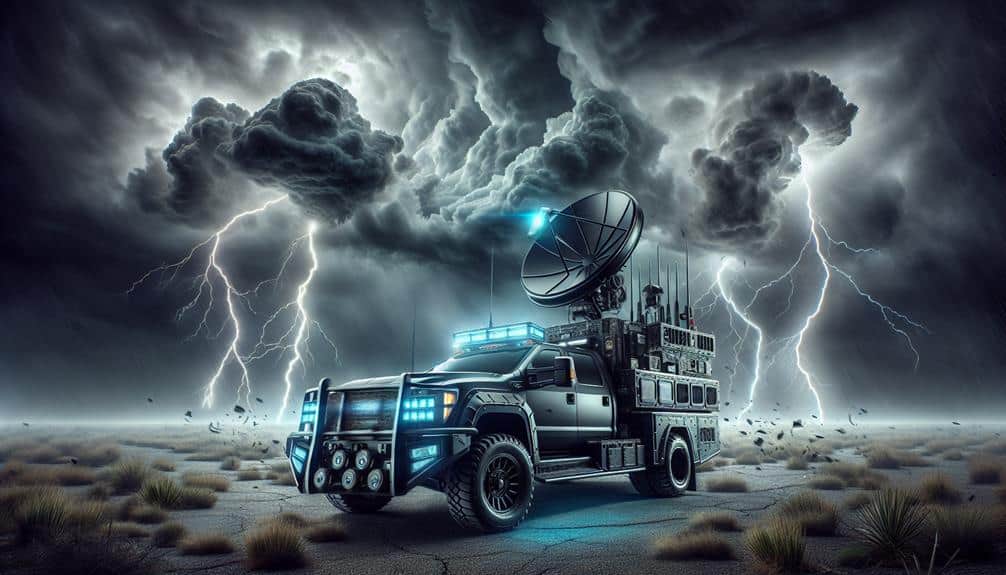We've witnessed remarkable advancements in Doppler radar for storm chasers. Modern technology blends high computing power, advanced remote sensing, and machine learning to detect storm patterns faster. Portable Doppler systems allow us to collect real-time, high-resolution data in diverse terrains, enhancing storm tracking accuracy. Real-time updates and data visualization platforms improve our decision-making speed and situational awareness, ensuring we can respond swiftly to changing conditions. The integration of these technologies not only heightens our ability to forecast severe weather but also enhances public safety by providing timely updates. For a deeper insight into these innovations, explore further.
Key Points
- Portable Doppler systems enable flexible, real-time storm tracking and data collection in diverse terrains.
- Enhanced computing power and machine learning algorithms provide quicker storm pattern identification for storm chasers.
- High-resolution real-time data improves forecasting accuracy, offering storm chasers better predictive insights.
- Advanced remote sensing techniques enhance data capture and storm feature identification with greater precision.
Early Doppler Radar Use
Early Doppler radar use began during World War II to detect enemy aircraft and submarines, greatly enhancing wartime surveillance capabilities. By harnessing the Doppler effect, we observed shifts in frequency caused by moving objects, allowing us to pinpoint their location and speed. This technological leap held historical significance as it revolutionized the way we approached both military strategy and scientific observation.
Post-war, the application of Doppler radar in meteorology marked a profound breakthrough. We adapted the technology to track weather patterns, which led to unprecedented advances in predicting severe weather events. Doppler radar enabled us to measure wind velocity and precipitation intensity with remarkable accuracy, fundamentally transforming meteorological science.
The newfound ability to detect and analyze storm movements in real-time had a direct impact on public safety. It allowed for more timely and precise weather warnings, saving countless lives and mitigating property damage.
As storm chasers, we owe much to these early innovations; they laid the groundwork for the sophisticated systems we rely on today. By understanding the historical significance of early Doppler radar use, we can appreciate the pivotal meteorological breakthroughs that continue to offer us greater freedom and security in the face of nature's unpredictability.
Modern Technological Improvements
With advancements in computing power and signal processing, we've achieved significant enhancements in Doppler radar technology, enabling more accurate and faster data interpretation. Modern Doppler radar systems now employ advanced remote sensing techniques that allow us to capture high-resolution atmospheric data. By integrating machine learning algorithms with traditional radar data, we can identify storm patterns more quickly and with greater precision.
Data visualization platforms have also drastically improved. These tools convert complex radar data into easily interpretable visual formats, allowing storm chasers to make real-time decisions with confidence. Enhanced graphical interfaces and 3D modeling capabilities present a more inclusive picture of storm dynamics, including wind speed, direction, and precipitation intensity.
The shift from analog to digital signal processing has reduced latency, enabling more timely updates and increasing the radar's ability to track rapidly evolving weather systems. Additionally, dual-polarization technology provides more detailed information on precipitation type, improving our ability to predict severe weather events.
Portable Doppler Systems
Portable Doppler systems have revolutionized meteorological fieldwork, offering unparalleled flexibility and precision in storm tracking and data collection. These compact units allow us to quickly deploy in the field, providing real-time data that's crucial for understanding storm dynamics.
By integrating GPS and wireless communication technologies, we can perform remote monitoring, which greatly enhances our ability to track severe weather events from a safe distance.
In terms of field deployment, portable Doppler systems are engineered for swift setup and mobility. Lightweight and durable, these systems can be rapidly transported and assembled in diverse terrains, from open plains to urban environments. This adaptability allows us to position the radar units efficiently, thereby capturing more accurate and detailed measurements of storm characteristics.
Remote monitoring capabilities further amplify the usefulness of portable Doppler systems. We can access live data feeds and control the radar parameters from remote locations, reducing the need for constant on-site presence. This not only ensures the safety of our team but also allows for continuous data collection even when conditions become too hazardous for direct observation.
Enhanced Data Accuracy
Utilizing the mobility and remote capabilities of portable Doppler systems, we can achieve greatly improved data accuracy in storm analysis. Our ability to position these systems closer to storm cells allows us to collect high-resolution data in real-time. This mobility translates directly into enhanced forecasting accuracy and improved storm detection, essential for anticipating severe weather events.
By analyzing finer details within storm structures, we can identify key features such as rotation, wind speed, and precipitation intensity with greater precision. This detailed information is critical in increasing warning times, allowing communities more time to implement better safety measures. The enhanced data accuracy also aids in refining predictive models, making our forecasts more reliable and actionable.
With portable Doppler systems, we're not bound by the limitations of fixed radar installations. This freedom to relocate and adapt our observation points means we can gather data from previously inaccessible areas. As a result, our storm detection capabilities are significantly heightened, providing a thorough view of storm dynamics.
Real-Time Tracking Capabilities

Real-time tracking capabilities empower meteorologists to continuously monitor storm developments and make rapid adjustments to forecasts as new data emerges. By leveraging advanced Doppler radar technology, we gain unparalleled insights into storm dynamics, which are essential for accurate predictions and timely warnings.
With real-time tracking, we can:
- Access live updates: Constant streams of data guarantee we're always informed about the latest storm movements and intensities.
- Utilize remote access: Meteorologists can monitor storm data from anywhere, enhancing our capacity to respond swiftly to changing conditions.
- Enhance predictive models: Continuous data feeds enhance the accuracy of our predictive algorithms, allowing for more precise forecasts.
- Increase situational awareness: Real-time visuals and data overlays help us understand the storm's structure and potential impact areas.
Frequently Asked Questions
How Does Doppler Radar Impact Storm Prediction Models?
Doppler radar accuracy greatly enhances storm tracking, leading to forecasting improvement. By precisely identifying severe weather patterns, we can better predict storm paths and intensities, providing more reliable warnings and safeguarding our freedom to prepare effectively.
What Are the Main Limitations of Current Doppler Radar Technology?
Imagine we're explorers with a map missing key details. Doppler radar limitations are like that; we need technological improvements for better forecast accuracy and data resolution. Let's push for advancements that liberate us from these constraints.
How Do Storm Chasers Collaborate With Meteorologists Using Doppler Radar Data?
We collaborate closely with meteorologists through field communication, enhancing data analysis. Real-time tracking improves forecasting accuracy, enabling us to share critical information swiftly and efficiently, ensuring precise predictions and timely alerts for maximum safety and preparedness.
What Training Is Required to Operate Advanced Doppler Radar Systems?
Training to operate advanced Doppler radar systems is a double-edged sword requiring both radar operation skills and meteorological understanding. We undergo rigorous coursework and hands-on experience, ensuring we're equipped to interpret and utilize this technology effectively.
Can Doppler Radar Detect Other Severe Weather Phenomena Besides Tornadoes?
Yes, Doppler radar can detect other severe weather phenomena. We can identify lightning strikes and hail detection with high precision. This capability enhances our ability to forecast and respond to severe weather, ensuring safety and preparedness.


